
The Canary Islands, also known informally as the Canaries, are a Spanish autonomous community and archipelago in Macaronesia in the Atlantic Ocean. At their closest point to the African mainland, they are 100 kilometres west of Morocco and the Western Sahara. They are the southernmost of the autonomous communities of Spain. The islands have a population of 2.2 million people and are the most populous special territory of the European Union.
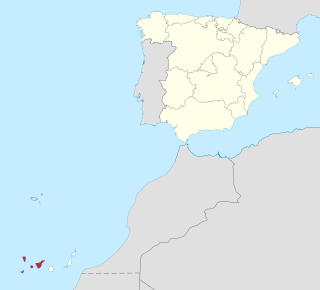
Province of Santa Cruz de Tenerife, also Province of Santa Cruz, is a province of Spain, consisting of the western part of the autonomous community of the Canary Islands. It consists of about half of the Atlantic archipelago: the islands of Tenerife, La Gomera, El Hierro, and La Palma. It occupies an area of 3,381 km2 (1,305 sq mi). It also includes a series of adjacent roques.
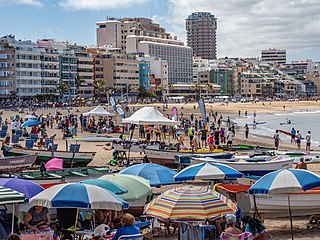
Las Palmas, officially Las Palmas de Gran Canaria, is a Spanish city and capital of Gran Canaria, in the Canary Islands, in the Atlantic Ocean.

Gran Canaria, also Grand Canary Island, is the third-largest and second-most-populous island of the Canary Islands, an archipelago off the Atlantic coast of Northwest Africa and is part of Spain. As of 2019 the island had a population of 851,231 that constitutes approximately 40% of the population of the archipelago. Las Palmas de Gran Canaria, the capital of the island, is the biggest city of the Canary Islands and the ninth of Spain.

Tenerife is the largest and most populous island of the Canary Islands. It is home to 43% of the total population of the archipelago. With a land area of 2,034 square kilometres (785 sq mi) and a population of 978,100 inhabitants as of January 2022, it is also the most populous island of Spain and of Macaronesia.

Santa Cruz de Tenerife, commonly abbreviated as Santa Cruz, is a city, the capital of the island of Tenerife, Province of Santa Cruz de Tenerife, and one of the capitals of the Canary Islands, along with Las Palmas. Santa Cruz has a population of 206,593 (2013) within its administrative limits. The urban zone of Santa Cruz extends beyond the city limits with a population of 507,306 and 538,000 within urban area. It is the second largest city in the Canary Islands and the main city on the island of Tenerife, with nearly half of the island's population living in or around it.
Los Realejos is a town and a municipality in the northern part of the island of Tenerife, which is the biggest town in the Canary Islands. It is part of the province of Santa Cruz de Tenerife, Spain. The town is located 2 km (1.2 mi) from the north coast, 5 km (3.1 mi) southwest of Puerto de la Cruz, 6 km (3.7 mi) west of La Orotava, and 34 km (21 mi) southwest of the island's capital Santa Cruz de Tenerife. The inhabitants are known in Spanish as realejeros.

Arona is a municipality in the southern part of the island of Tenerife in the Canary Islands, Spanish region and archipelago in the Atlantic Ocean, in Macaronesia. The municipality covers an area of 81.79 square kilometres comprising 4% of the island's area. The town of Arona is 59 km southwest of Santa Cruz de Tenerife, the island's capital. The population in 2017 was about 93,496. It is the third largest city in Tenerife, after, Santa Cruz de Tenerife and San Cristóbal de La Laguna. Arona has a pleasant climate with temperatures ranging from 20 to 25 degrees Celsius. Notable places include the tourist resorts of Los Cristianos, Playa de las Americas, Costa del Silencio and Las Galletas. Arona also features Punta Salemas, the southernmost point of the island of Tenerife. The TF-1 motorway passes through the municipality.
The Second Battle of Acentejo was a battle that took place on 25 December 1494 between the invading Spanish forces and the natives of the island of Tenerife, known as Guanches. The battle had been preceded by the Battle of Aguere, fought on 14-15 November that year, which had been a Castilian victory.

Adeje is a town and municipality in the southwestern part of the island of Tenerife, one of the Canary Islands, and part of the province of Santa Cruz de Tenerife, Spain. The town Adeje is located 4 km from the coast, 8 km north of the resort town Los Cristianos, 60 km southwest of the island capital Santa Cruz de Tenerife and about 17 km northwest of Tenerife South Airport.
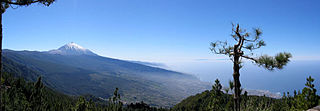
The Orotava Valley is an area in the northern part of the island of Tenerife, Canary Islands, Spain. The valley measures 10 kilometres (6.2 mi) by 11 km, and stretches from the north coast to about 2,000 m elevation, at the northern foot of Pico del Teide.

La Orotava is a town and a municipality in the northern part of Tenerife, one of the Canary Islands of Spain. The area of the municipality stretches from the north coast to the mountainous interior, and includes the summit of the Teide volcano, Canary Islands' and Spain's highest point at 3,718 m. At 207.31 km2, it is the largest municipality of the island of Tenerife. The population is 41,255 (2013).

La Victoria de Acentejo is a town and a municipality in the northern part of the island Tenerife, Canary Islands, Spain. It is located near the north coast, 2 km southwest of La Matanza de Acentejo, 7 km northeast of La Orotava and 22 km west of the island capital Santa Cruz de Tenerife. The TF-5 motorway passes through the municipality. The population is 9,069 (2013) and the area is 18.36 km2.
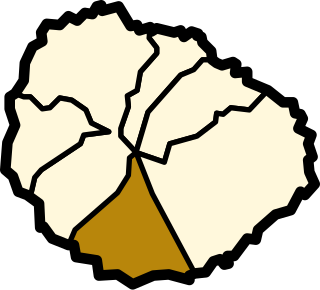
Alajeró is a municipality on the island of La Gomera in the province of Santa Cruz de Tenerife in the Canary Islands. It is located on the south coast, SW of the capital San Sebastián de la Gomera. As well as being a municipality, Alajeró is also the name of the administrative town that governs that municipality.
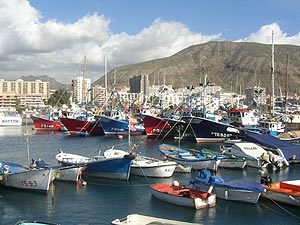
Los Cristianos is a town in Spain with a population of 21,235 (2017), situated on the south coast of the Canary Island of Tenerife. Located in the municipality of Arona between the cone of the mountain Chayofita and the greater mountain Guaza. The town centre is around the Los Cristianos bay, but is rapidly expanding inland with modern development. The town is a popular tourist resort and includes a ferry port and two beaches.

On the island of Tenerife, in the Canary Islands, many sports are practiced, both outdoors and indoors in the various facilities available throughout the island.
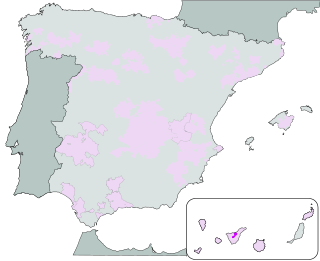
Valle de la Orotava is a Spanish Denominación de Origen Protegida (DOP) for wines located on the north-western coastline of Tenerife,, and acquired its DO in 1995.

Taoro was one of nine Guanche menceyatos in which the island of Tenerife was divided at the time of the arrival of the conquering Spaniards.
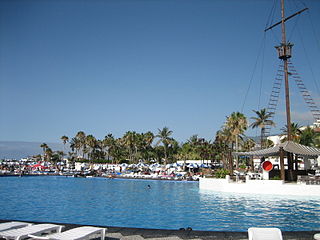
Lago Martiánez is an open-air swimming pool complex located in Puerto de la Cruz. The leisure park with a total area of approximately 100,000 square meters is centered around an artificial lake. Lago Martiánez includes several islands, gardens, restaurants, bars, and terraces. Architect César Manrique designed the swimming pool complex with many volcanic rocks. Lago Martiánez is a mix of Manrique’s vision and local elements, such as bartizans, palisades and ocean views. In addition to the architectural structure, it also comprises a range of Manrique’s sculptures. Lago Martiánez, commonly known as "el Lago", was built in the so-called "Llanos de Martiánez" area, which was home to several natural pools. The first tourists visited Llanos de Martiánez at the end of the 19th century and at the beginning of the 20th century.

Alfred Diston was a British merchant and writer on a wide variety of subjects who lived in Puerto de la Cruz, Tenerife, between 1810 and 1861.








































